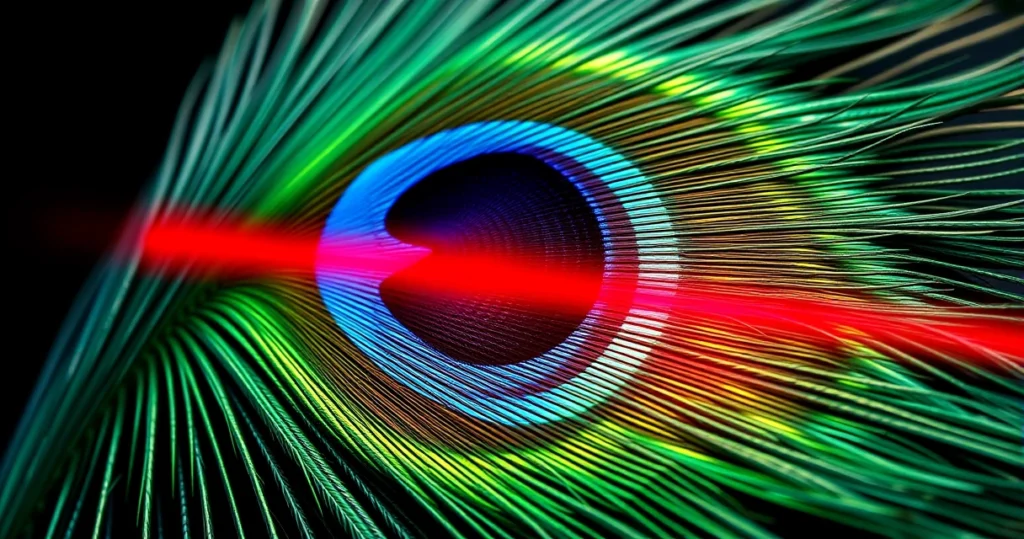Discover How Peacock Feathers Could Inspire Biocompatible Laser Technology
In a remarkable intersection of nature and technology, scientists are turning their attention to the vibrant and intricate plumage of peacocks to innovate biocompatible laser technology. The stunning colors and patterns of peacock feathers have long fascinated researchers, but recent studies suggest that these natural wonders could inspire advancements in medical technology, particularly in the development of lasers that can be safely embedded within the human body. This article delves into how the unique properties of peacock feathers could lead to groundbreaking applications in laser technology, potentially transforming the landscape of medical procedures.

As the demand for safer, more effective medical technologies grows, the search for biocompatible solutions has intensified. Traditional lasers, while effective, often pose risks when used in or on the human body due to potential tissue damage or adverse reactions. The plumage project, inspired by the structural coloration of peacock feathers, aims to create lasers that not only minimize these risks but enhance the precision and efficacy of medical treatments. This exploration into biocompatible lasers is not just a theoretical endeavor; it represents a promising future for patient care and surgical outcomes.
The Science Behind Peacock Feathers
Peacock feathers are renowned for their extraordinary coloration, which is not solely due to pigments but rather to their unique microstructure. The feathers contain tiny microscopic structures that manipulate light in such a way that they produce vibrant colors and iridescence. This phenomenon is known as structural coloration, where light interacts with the physical structure of the material rather than being absorbed or reflected by pigments. Understanding this intricate structure is key to developing biocompatible laser technology.
Understanding Structural Coloration
Structural coloration occurs when light waves reflect off microscopic surfaces, creating vivid colors. In peacock feathers, these surfaces are composed of layers of microscopic platelets made of keratin. The arrangement and spacing of these layers determine which wavelengths of light are reflected, giving rise to the stunning blues and greens characteristic of peacock plumage. Researchers are studying these properties to create lasers that can mimic this effect, potentially allowing for safer interactions with biological tissues.
Potential Applications of Biocompatible Lasers
Biocompatible lasers inspired by peacock feathers could have various applications in the medical field. Here are some potential uses:
- Minimally Invasive Surgery: Lasers can be used for cutting and cauterizing tissue with precision, minimizing damage to surrounding areas.
- Targeted Drug Delivery: Lasers can activate drug delivery systems precisely at the site of interest, increasing efficacy while reducing side effects.
- Phototherapy: Lasers can be used in treatments for skin conditions, cancers, and other diseases, providing a non-invasive treatment option.
- Bioimaging: Advanced laser technologies can enhance imaging techniques, allowing for better diagnosis and monitoring of diseases.
The Plumage Project: A Closer Look
The Plumage Project is an ongoing research initiative aimed at harnessing the unique characteristics of peacock feathers to develop biocompatible lasers. This project brings together experts in materials science, optics, and biomedical engineering, creating a multidisciplinary approach to innovation. The goal is to create laser devices that not only perform effectively but are also safe for use within the human body.
Research Methodologies
Researchers involved in the Plumage Project employ various methodologies, including:
- Materials Synthesis: Creating synthetic materials that replicate the microstructures found in peacock feathers.
- Optical Testing: Assessing how these synthetic materials interact with light to optimize laser performance.
- Biocompatibility Assessment: Conducting tests to ensure that the materials are safe for human use and do not provoke adverse reactions.
Collaborative Efforts
The Plumage Project is not limited to a single institution; it involves collaboration between universities, research institutions, and industry partners. This collaborative spirit fosters innovation and accelerates the development of biocompatible laser technology. By pooling resources and expertise, the project aims to bring these technologies from the lab to clinical applications efficiently.
Advantages of Biocompatible Lasers
The potential advantages of biocompatible lasers inspired by peacock feathers extend beyond safety. Here are key benefits:
- Reduced Healing Time: The precision of lasers minimizes trauma to surrounding tissues, potentially leading to faster recovery times for patients.
- Lower Risk of Infection: Minimally invasive procedures reduce the likelihood of surgical site infections, a significant concern in traditional surgeries.
- Enhanced Treatment Efficacy: Targeted treatments can improve the effectiveness of therapies, particularly in cancer treatments and regenerative medicine.
- Versatility: Biocompatible lasers can be tailored for various medical applications, from dermatology to orthopedics.
Challenges and Future Directions
While the prospects of biocompatible lasers inspired by peacock feathers are promising, several challenges remain. Researchers must address issues such as:
- Material Durability: Ensuring that synthetic materials can withstand bodily conditions over time without degrading.
- Regulatory Approvals: Navigating the complex landscape of medical device regulations to bring new technologies to market.
- Cost-Effectiveness: Developing scalable manufacturing processes that allow for affordable production of biocompatible lasers.
Future research will likely focus on overcoming these challenges while continuing to explore the vast potential of structural coloration found in nature. As technology advances, we can anticipate exciting developments that will redefine the boundaries of medical technology.
FAQs
1. What are biocompatible lasers?
Biocompatible lasers are laser technologies designed to be safe for use within the human body, minimizing the risk of adverse reactions and tissue damage.
2. How do peacock feathers inspire laser technology?
The unique microstructure of peacock feathers, which creates vibrant colors through structural coloration, can inspire the design of lasers that interact safely with biological tissues.
3. What are some potential applications of biocompatible lasers?
Biocompatible lasers could be used in minimally invasive surgery, targeted drug delivery, phototherapy, and advanced bioimaging techniques.
4. What challenges do researchers face in developing biocompatible lasers?
Challenges include ensuring material durability, navigating regulatory approvals, and developing cost-effective manufacturing processes.
5. Is the Plumage Project the only research initiative exploring this technology?
While the Plumage Project is a leading initiative, other research institutions and companies are also exploring the potential of biocompatible lasers inspired by natural structures.
Conclusion
The exploration of peacock feathers as a source of inspiration for biocompatible laser technology represents an exciting frontier in medical innovation. With their unique structural coloration and the potential for safe, effective applications, these natural wonders could lead to significant advancements in the way medical procedures are performed. As research continues and collaborations strengthen, the dream of embedding biocompatible lasers within the human body may soon become a reality, paving the way for safer and more effective treatments. The Plumage Project exemplifies the beauty of interdisciplinary collaboration, harnessing the brilliance of nature to inspire the technologies of tomorrow.
📰 Original Source
Este artigo foi baseado em informações de: https://www.wired.com/story/peacock-feathers-laser-beams/



